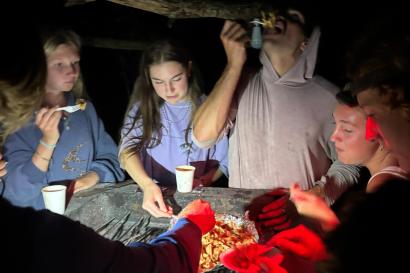We were told upon arriving never to eat street food. In the centers of Ecuadorian cities and towns, vendors line the sidewalks selling everything from pig skin to papaya beneath colorful umbrellas. The smoky smell of cooking meat wafts through the streets from little grills on wheels. You can buy a complete meal, cooked right in front of you, from the side of the cobblestone road for $1.50. But it’s not the low prices alone that make this part of Ecuadorian culture so novel to me. It’s the accessibility of an actual meal, of whole, traditional food that has been eaten in this place for centuries. It’s not fried, processed stuff off a conveyor belt; it’s real food made by a real human being. It’s a “plato tradicional” of chicken, yucca, and red cabbage, or rice and goat and red onion salad. And it’s always, always a little bowl of homemade ají, hot sauce made from tree tomato, peppers, cilantro, garlic, and onion.
“It’s not very clean,” they told us during orientation. “They don’t use bottled water; they might not wash their hands.” And for the first few overly-cautious days I fiercely guarded my intestines and never dreamed of straying from my hygienic path. But about the time I stopped thinking that everyone was trying to drug me with scopolamine (another orientation-induced paranoia), I lost the ability to resist street food. I sat with some friends at a little plastic table on the streets of a little town in the Highlands and dipped my spoon into the bowl of ají. We paid $1.75 each for our Quechua breakfasts of fried eggs, pasta, peas, beef, rice, and lettuce. “Muy rico,” we told the woman in traditional dress, a long sleeved white shirt hand-embroidered with purple flowers, woolen skirt reaching her ankles, dark hair wrapped tightly with bright fabric halfway down a dark braid. She piled more rice onto our plates. We sat in the morning sun and watched a man making fresh juice across the street, squeezing oranges into a bowl and tossing their yellow-green rinds into the growing pile beside him.
The affordability, cultural experience, and taste provided by street food have made it an easy choice for me. Choosing a meal is always worth some caution when the place is new and the bacteria foreign, but street food has done me no harm thus far. It’s been good for my health, good for my wallet, and good for the people of this country, for the traditionally spicy, salty, and colorful culture which I have the privilege to experience in all its richness.

Grace Glynn
<p><span style="color: rgb(29, 29, 29); font-family: Arial, Verdana, sans-serif; font-size: 12px; line-height: normal; background-color: rgb(237, 237, 237);">Grace is a junior at Connecticut College with a major in botany. She grew up on the coast of Maine and looks forward to leaving its harsh winter for the equatorial Galapagos Islands. Grace’s interests include paleontology, backpacking, folk music, and fermented foods. Join her as she heads to Ecuador for the semester!</span></p>






